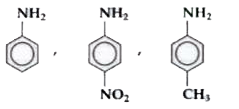Arrange the following alcohols in the increasing order of reactivity with HBr,
C6H5CH2OH,C6H5_(2)CHOH,(C6H6)3COH,p−ClC6H4CH2OH,p−NO2C6H4CH2OH
To arrange the given alcohols in increasing order of reactivity with HBr, we need to consider the stability of the carbocations formed during the reaction. The more stable the carbocation, the more reactive the alcohol will be.
1. Identify the Alcohols:
- Benzyl alcohol: C6H5CH2OH
- Diphenylmethanol: C6H5C6H5CHOH
- Triphenylmethanol: (C6H5)3COH
- p-Chlorobenzyl alcohol: p−ClC6H4CH2OH
- p-Nitrobenzyl alcohol: p−NO2C6H4CH2OH
2. Understand the Reaction with HBr:
- When alcohols react with HBr, the hydroxyl group (-OH) is protonated, forming a better leaving group. This leads to the formation of a carbocation.
3. Analyze Carbocation Stability:
- Benzyl alcohol: Forms a primary carbocation, which can be stabilized by resonance with the phenyl ring.
- Diphenylmethanol: Forms a secondary carbocation, which is more stable due to resonance with two phenyl rings.
- Triphenylmethanol: Forms a tertiary carbocation, which is the most stable due to resonance with three phenyl rings.
- p-Chlorobenzyl alcohol: The chlorine atom is electronegative and can destabilize the carbocation, but it still allows for some resonance stabilization.
- p-Nitrobenzyl alcohol: The nitro group is a strong electron-withdrawing group, which destabilizes the carbocation significantly.
4. Rank the Alcohols:
- The least reactive alcohol will be the one that forms the least stable carbocation.
- p-Nitrobenzyl alcohol will be the least reactive due to the destabilizing effect of the nitro group.
- Next will be p-Chlorobenzyl alcohol due to the electron-withdrawing effect of chlorine.
- Following that is Benzyl alcohol, which has resonance stabilization.
- Then comes Diphenylmethanol, which has more resonance stabilization than benzyl alcohol.
- Finally, Triphenylmethanol will be the most reactive due to the highest stability of the tertiary carbocation.
Final Order:
The increasing order of reactivity with HBr is:
1. p−NO2C6H4CH2OH (least reactive)
2. p−ClC6H4CH2OH
3. C6H5CH2OH
4. C6H5C6H5CHOH
5. (C6H5)3COH (most reactive)
- Benzyl alcohol: C6H5CH2OH
- Diphenylmethanol: C6H5C6H5CHOH
- Triphenylmethanol: (C6H5)3COH
- p-Chlorobenzyl alcohol: p−ClC6H4CH2OH
- p-Nitrobenzyl alcohol: p−NO2C6H4CH2OH
- When alcohols react with HBr, the hydroxyl group (-OH) is protonated, forming a better leaving group. This leads to the formation of a carbocation.
- Benzyl alcohol: Forms a primary carbocation, which can be stabilized by resonance with the phenyl ring.
- Diphenylmethanol: Forms a secondary carbocation, which is more stable due to resonance with two phenyl rings.
- Triphenylmethanol: Forms a tertiary carbocation, which is the most stable due to resonance with three phenyl rings.
- p-Chlorobenzyl alcohol: The chlorine atom is electronegative and can destabilize the carbocation, but it still allows for some resonance stabilization.
- p-Nitrobenzyl alcohol: The nitro group is a strong electron-withdrawing group, which destabilizes the carbocation significantly.
- The least reactive alcohol will be the one that forms the least stable carbocation.
- p-Nitrobenzyl alcohol will be the least reactive due to the destabilizing effect of the nitro group.
- Next will be p-Chlorobenzyl alcohol due to the electron-withdrawing effect of chlorine.
- Following that is Benzyl alcohol, which has resonance stabilization.
- Then comes Diphenylmethanol, which has more resonance stabilization than benzyl alcohol.
- Finally, Triphenylmethanol will be the most reactive due to the highest stability of the tertiary carbocation.
The increasing order of reactivity with HBr is:
1. p−NO2C6H4CH2OH (least reactive)
2. p−ClC6H4CH2OH
3. C6H5CH2OH
4. C6H5C6H5CHOH
5. (C6H5)3COH (most reactive)
Topper's Solved these Questions
- BOOK - MODERN PUBLICATIONCHAPTER - ALCOHOLS, PHENOLS AND ETHERSEXERCISE - OBJECTIVE TYPE QUESTIONS (MULTIPLE CHOICE QUESTIONS) (M.C.Q) (MULTIPLE CHOICE QUESTIONS with only one corrrect answer)30videos
ALCOHOLS, PHENOLS AND ETHERS
- BOOK - MODERN PUBLICATIONCHAPTER - ALCOHOLS, PHENOLS AND ETHERSEXERCISE - OBJECTIVE TYPE QUESTIONS (MULTIPLE CHOICE QUESTIONS) (from competitive examinations) (AIPMT, NEET & OTHER STATE BOARD.S MEDICAL ENTRANCE)23videos
ALCOHOLS, PHENOLS AND ETHERS
- BOOK - MODERN PUBLICATIONCHAPTER - ALCOHOLS, PHENOLS AND ETHERSEXERCISE - Revision Exercises (Long Answer Questions)2videos
ALCOHOLS, PHENOLS AND ETHERS
- BOOK - MODERN PUBLICATIONCHAPTER - ALDEHYDES ,KETONES AND CARBOXYLIC ACIDSEXERCISE - UNIT PRACTICE TEST13videos
ALDEHYDES ,KETONES AND CARBOXYLIC ACIDS
Similar Questions
Knowledge Check
- Question 1 - Select One
C6H5CH2OH is
APhenolBAlcoholCCarbolic acidD(a) and (c) - Question 2 - Select One
Arrange the following alcohols in increasing order of their reactivity towards the reaction with HCl (CH3)2CH−OH(1),(CH3)3C−OH(2),(C6H5)3C−OH(3)
A1<2<3B2<1<3C3<1<2D2<3<1 - Question 3 - Select One
Place the following benzyl alcohols in decreasing order of reaction rate with HBr
C6H5CH2(A)OH , p−O2NC6(B)H4CH2OH
p−CH3OC6H4Ch2OH , p−ClC6(D)H4CH2OHAC>A>D>BBA>C>D>BCC>A>B>DDA>C>B>D
Arrange the following in increasing order basic strength :
(i) C6H5−NH2,C6H5CH2−NH2,C6H5NH−CH3
(ii) View Solution
View SolutionArrange the following in decreasing order of solubility in water
(i) CH3CH2OH (ii) CH3OH (iii) C6H5CH2OH.View SolutionArrange the following in incresing order of basic strength :
C6H5NH2,C2H5NHCH3,C6H5N(CH3)2.View SolutionArrange the following in increasing order of their basic strength:
(i) C2H5NH2,C6H5NH2,NH3,C6H5CH2NH2and(C2H5)2NH
(ii) C2H5NH2,(C2H5)2NH,(C2H5)3N,C6H5NH2
(iii) CH3NH2,(CH3)2NH,(CH3)3N,C6H5CH2NH2.View SolutionArrange the following compound in increasing order of reactivity towards nucleophilic addition reaction
(I) C6H5COCH3 (II) CH3CO−C2H5
C6H5CHO (IV) CI−CH2−CHOView Solution

